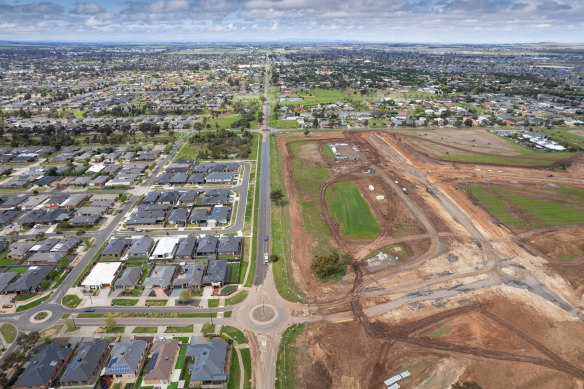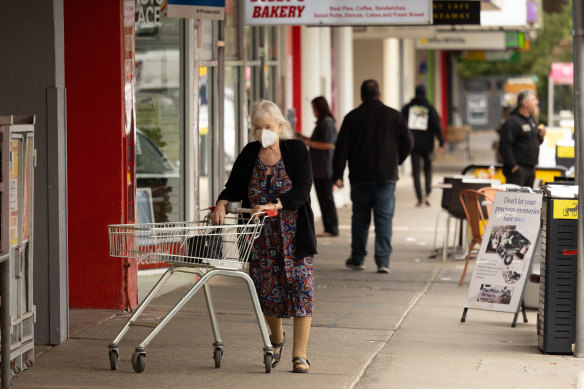By Adam Carey
A failure to foresee the runaway pace of population growth in Melbourne’s outer west has left a local council hundreds of millions of dollars short of the money it needs for new roads, bridges, bike trails, community halls and kindergartens.
The council will lean on the development sector to fill the financial black hole, jacking up levies in a move the housing industry warns will add tens of thousands of dollars to the cost of each new home and potentially stall some developments.

Growing greenfield housing developments in Melton in Melbourne’s outer west.Credit: Jason South
The City of Melton has identified a $224 million shortfall in the funding it needs to build infrastructure for several new and expanding suburbs on Melbourne’s fringe, and wants to increase the levies developers must pay by more than 50 per cent to plug the gap.
But affected developers are pushing back, warning in a series of submissions to the council that they will pass the extra costs onto home buyers, and that some housing projects in Melton will become financially unviable, reducing availability and affordability in the middle of a housing crisis.
The dispute points to the growing challenge and cost of building new suburbs on Melbourne’s fringes. The City of Wyndham similarly identified a funding shortfall of more than $530 million last year, forcing it to contemplate cutting the number of kindergartens, libraries and sports fields it would build in growing suburbs such as Tarneit.
Melton City Council voted to seek to increase developer levies by an average of 56 per cent in a large area of Melton called the Toolern precinct, in a move that would cover $176 million of the $224 million infrastructure funding shortfall. It will seek state grants to cover the rest, which cannot be clawed back from developers because those parts of Toolern have already been built.
A recent council analysis of plans for several emerging suburbs in the Toolern precinct, including Cobblebank, Weir Views, Strathtulloh and Thornhill Park, uncovered the miscalculation of developer contributions, which growth-area councils rely on to build infrastructure for new housing.
Melton is the fastest growing place in Australia, census data shows, and the population boom has led planners to severely underestimate the investment needed to build community infrastructure.
The developer contribution rates for Toolern were first calculated in 2010, and were based on an expected future population of 55,000. But the precinct is now expected to grow to 68,000 people – roughly the population of Shepparton.
The City of Melton said that without its proposed increase in developer levies, it might not be able to build the infrastructure future residents and businesses will need. Alternatively, it would have to cut council services in other areas or go into debt to raise the necessary funds.

High Street, Melton’s traditional commercial heart.Credit: Jason South
Councillor Sophie Ramsey said Toolern’s development plan was well over 10 years old and needed an update to reflect changes on the ground.
“We are continually growing and … there is so much demand for quality council services and quality council infrastructure that we need to bring things into line,” she said at the June 24 council meeting.
Developers who would have to pay the higher levies have lambasted the proposed hikes and warned they would ensure that future buyers pay tens of thousands of dollars more for a new home in Melton.
Developer Growland calculated that the higher levy, combined with recent changes to the construction code mandating seven-star efficient homes, would add $25,000 to the cost of each block of land in Toolern.
Insight Planning said the council and the state should be doing more to minimise housing costs. “The increase in the levy rate will need to be passed onto future home owners as increased land costs, at a time there is an affordability and housing supply crisis,” it said.
The developer of Swarna Estate in Strathtulloh said the change would “kill” housing construction there, undermining the state government’s goal to build 800,000 new homes. “Estates like Swarna are needed to create new homes. Housing affordability is in a crisis,” the company said.
Swarna said the cost of developing land in Melton had increased by 20 to 30 per cent in the past year. “The proposed increase in this amendment will kill development and create a further burden to the delivery of housing in Victoria,” it said.
Sunaina Sharma and her family of four moved last year into a new estate called Millstone, which neighbours the partially built Swarna estate.
Life for Millstone’s new residents is affected by the piecemeal, stop-start nature of housing growth in Toolern. It has no community facilities of any kind. The estate is surrounded by empty paddocks, with one road in and out, and no playground for Sharma’s preschool-aged children.
“It’s a big problem,” Sharma said. “There is no park, it is almost a 15-minute drive to the nearest playground.”
The road into Millstone is in poor condition, and Sharma said she and her neighbours had emailed the Melton City Council urging them to fix it. She said she would move out if her family could afford to.
“We don’t have any options. If I could, I definitely would move out of here,” she said.
An expert planning panel will rule on whether Melton can update its planning scheme with higher development levies.
Get the day’s breaking news, entertainment ideas and a long read to enjoy. Sign up to receive our Evening Edition newsletter.